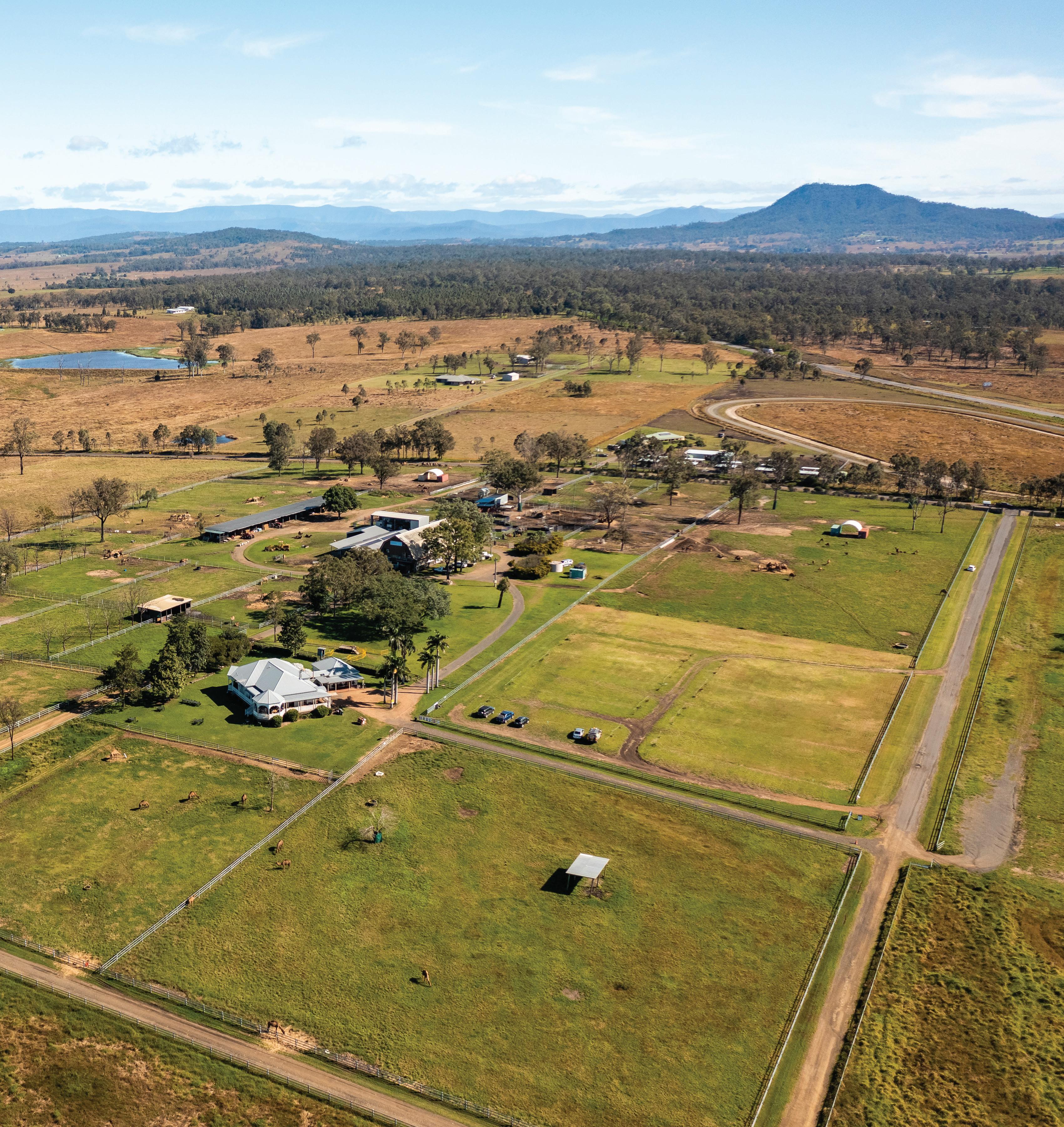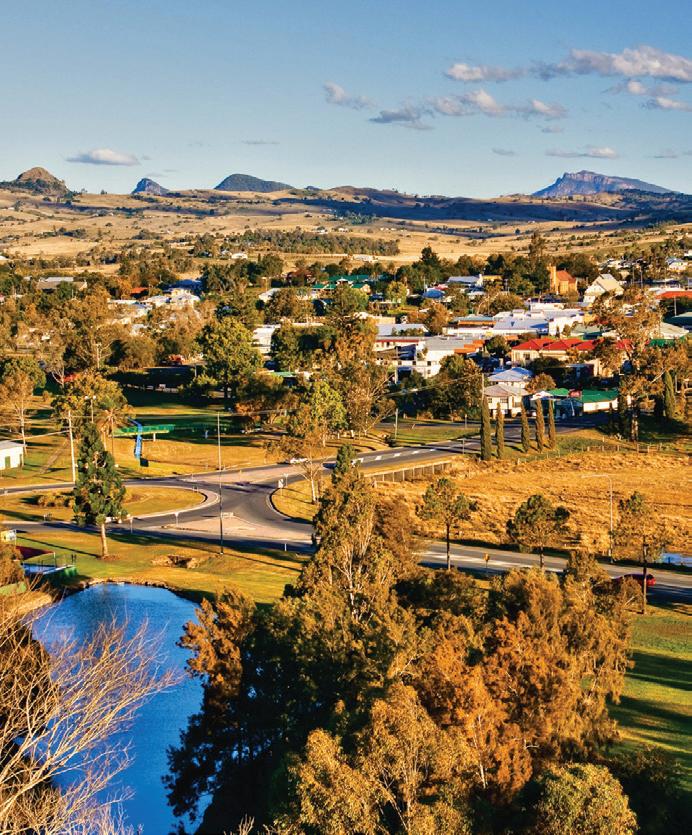
8 minute read
Strategic context
The Smart Region Strategy supports Council’s existing plans and strategies and aligns with wider Queensland and Australian government programs and initiatives. The Smart Region Strategy directly supports the outcomes of the Regional Prosperity Strategy 2020-2025, as well as the Scenic Rim 2026 Corporate Plan, the Scenic Rim Customer Charter and the Scenic Rim Customer Experience Strategy 2021-2023. The purpose of these strategies is to support the Council’s broader vision for the Scenic Rim to be a network of unique rural communities embedded in a productive and sustainable landscape, as outlined in the Scenic Rim Community Plan 2011-2026. The development of the Smart Region Strategy has also been driven and informed by factors external to Council. These include the aforementioned South East Queensland City Deal and the Brisbane 2032 Olympic and Paralympic Games, as well as the Australian Government’s 2021 Australian Infrastructure Plan, the Queensland Government’s State Infrastructure Strategy and Regional Infrastructure Plans and a range of other government and industry initiatives. To leverage existing investment and avoid duplication of effort, it is important that the Smart Region Strategy is informed by these external drivers.
Scenic Rim Community Plan 2011-2026
Supporting strategies Vision
Purpose
Key Themes
Scenic Rim 2026 Corporate Plan
Scenic Rim Regional Council
By 2026, Scenic Rim will be a network of unique rural communities embedded in a productive and sustainable landscape
To guide Council, other levels of government and community action on issues including the environment, economic development, social wellbeing, infrastructure and governance
Spectacular scenery and healthy environment Sustainable and prosperous economy Open and responsive government Relaxed living and rural lifestyles Vibrant towns and villages Accessible and Serviced Region Healthy, Engaged and Resourceful Communities
The region’s unique natural environment and rural landscapes are preserved and enhanced in partnership with our community
An enhanced regional brand underpins sustainable economic growth for businesses, strong local employment opportunities and high-performing primary production and tourism industries
Ethical and transparent leadership supports the diverse needs of our community via a high-performing and financially sustainable organisation Future growth opportunities, development and innovation enhance our lifestyle and preserve our natural assets and prime agricultural land Our vibrant towns and villages embrace their uniqueness, heritage values and sense of place Infrastructure and services support the prioritised needs of our growing community The social fabric of our growing region is friendly, active, healthy and inclusive
Scenic Rim Customer Charter
Scenic Rim Customer Experience Strategy 2021-23
Scenic Rim Regional Prosperity Strategy 2020-2025
We’ll acknowledge you and listen to your needs We’ll make dealing with us as easy as possible We’ll be open and honest, always We’ll follow through We’ll put our community first
Building a customer culture Enabling customer interactions Refining customer experience
1: Business and industry development Goal: Creating valuable jobs for locals
2: Marketing and promotion 3: Investment facilitation 4: Education and workforce development 5: Advocacy and infrastructure
Smart Region Strategy (this document)
To be an accessible and serviced region with a vibrant, sustainable and prosperous economy and community
Economy Leading an innovative and progressive economy attracting growth and investment
Place Enabling resilient and sustainable management to future proof communities and the environment
Community Creating inclusive, liveable, and supported communities that attract and retain residents

THE SMART REGION STRATEGY FRAMEWORK
At its heart, a smart region strategy needs to be placebased. The Scenic Rim is loved by locals and visitors alike because of its unique geography, history and character. While these are some of the region’s greatest assets, they also present challenges, for example the topography of the region, accentuated by mountains and valleys, challenges traditional transport and telecommunications infrastructure. For this reason, the Smart Region Strategy has been tailored to meet the unique needs of the Scenic Rim, and while it aligns with best practice and industry standards, it remains as unique as the region it serves. Importantly, the Smart Region Strategy is designed to
This will be achieved through investment in smart technologies and innovation focused in the areas of:
support existing initiatives in economic development, community engagement and support, and placemaking. This 10-year strategy, culminating in 2032, aims to take advantage of the once in a generation opportunity created by the Brisbane 2032 Olympic and Paralympic Games and the South East Queensland City Deal. The multibillion-dollar pipeline of funding from the Australian and Queensland Governments, and the national and international industry attention that will be directed towards the broader South East Queensland region, creates an exciting opportunity for the Scenic Rim.
VISION
Economy
Place
Community




THE JOURNEY TO A SMART REGION
WHAT IS IMPORTANT TO THE REGION
In developing the Smart Region Strategy, it was important to understand the current strengths and challenges of the community, including the economic position, business needs and community aspirations. These insights will allow the strategy to build on the strengths and overcome the challenges experienced in the region. Through engagement with community, business and internal Council stakeholders, we heard that the priorities for the region are to: • Improve internet and mobile connectivity throughout the region • Reduce the number of people who leave the region for work • Improve the efficiency and service to customers provided by businesses and Council through the adoption of new technology. We also heard that:
• The community values engagement and contributing to the future of the region • The people are the heart of the region, and there is a strong sense of community • The natural environment and the relaxed and rural lifestyle are important • There is a desire to grow sustainably and innovate.
WHAT SUCCESS LOOKS LIKE
In 2032, the Scenic Rim will be a network of unique rural communities and townships embedded in a productive and sustainable landscape. Smart collaboration, planning, design and local services will ensure full community and business participation in the digital economy, accelerating the adaptability and growth of the region. Businesses and the community will have access to reliable, high-speed internet and mobile reception, comparable to major cities, throughout the region, allowing them to take advantage of new technologies and the digital economy. The adoption of new technology – such as remote sensors, smart digital signage and automated IT systems – will improve the efficiency of Council services and enhance the interface between Council and the community, allowing better engagement and communication. The Scenic Rim’s towns and villages will remain vibrant and active, with free Wi-Fi, smart digital signage and infrastructure, and digitally interactive public art improving the amenity of public spaces and places. Similarly, increased access to data and information – such as real-time traffic, facility use, weather, and flood data – will continue to strengthen regional planning and investment decisions and enable more sustainable management of the built and natural environment. The Scenic Rim will be home to new industries – including technology, tertiary education and others in the knowledge economy – while existing industries, such as agriculture, retail, and tourism, will be using technology to grow from strength-to-strength. This economic growth, coupled with improved internet connectivity, will mean more residents will have access to rewarding and wellpaying jobs within the region and that less people need to leave the region for work. Similarly, the region will also be home to emerging and innovative technologies, such as driverless vehicles, passenger-carrying drones, automation, artificial intelligence, robotics and new telecommunications technology, which will be increasingly trialled in the region. This innovation will be supported by strong advocacy from Council and will attract investment and employment to the Scenic Rim. The region will also continue to be home to a thriving community of small businesses, supported through access to smart coworking spaces, strong support of innovation, and training in the skills they need to be successful in the digital world, such as ecommerce, digital marketing and data analytics.
HOW WE WILL GET THERE
While Scenic Rim Regional Council will lead and facilitate the implementation of the Smart Region Strategy, the success of the strategy will require business ownership and community support. In this regard, one of Council’s priorities is to act as an enabler, for both community engagement and industry investment. This ten-year strategy outlines a guiding vision and approach for the next ten years. The implementation roadmap focuses on the first five years, culminating in a review and renewal of the strategy for the following five years, to ensure it remains fit for purpose through to 2032. The five-year Roadmap outlines the course of actions and initiatives required to transform the Scenic Rim into a Smart Region where prosperous economic and sustainable community growth can be realised.

SMART REGION STRATEGIC ACTIONS
The Smart Region Strategy focuses on creating a great place to live, work and play by connecting the economy and built and natural environments with technology and data. Smart technologies maximise benefits, innovate service delivery and build and strengthen knowledge-based industries, providing the jobs of tomorrow. As shown over the following pages, each proposed technology and data investment has a clear line of sight to a measurable outcome.




